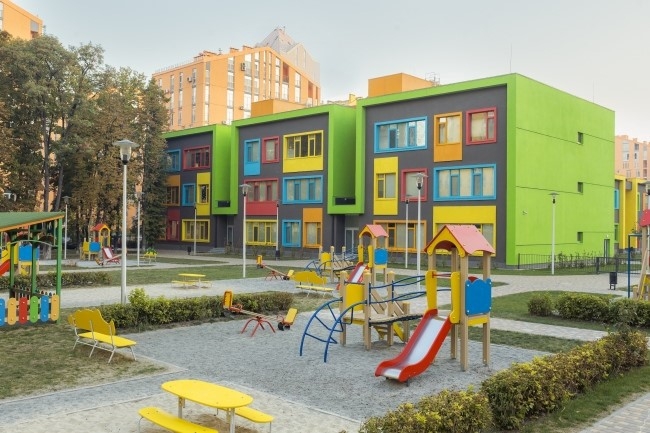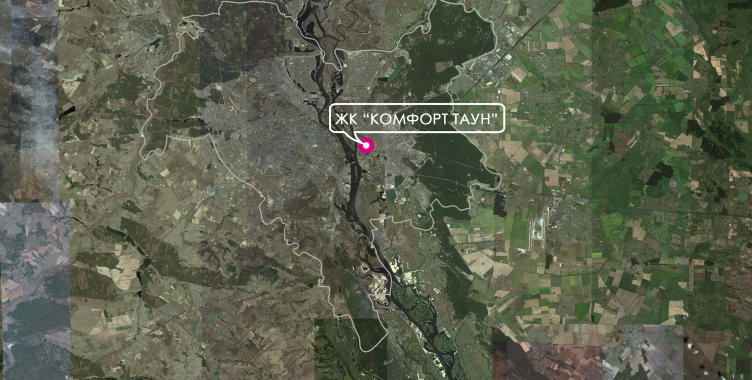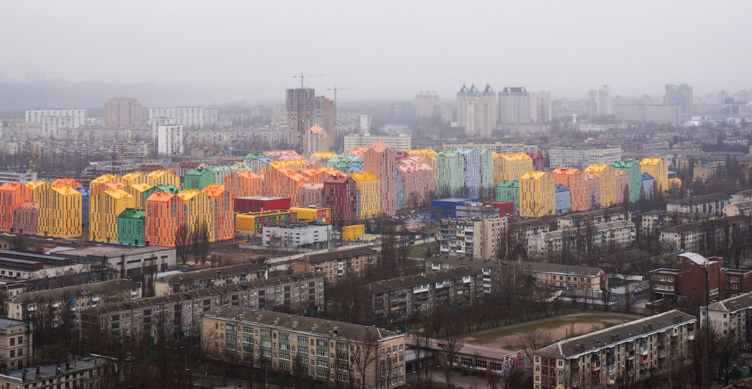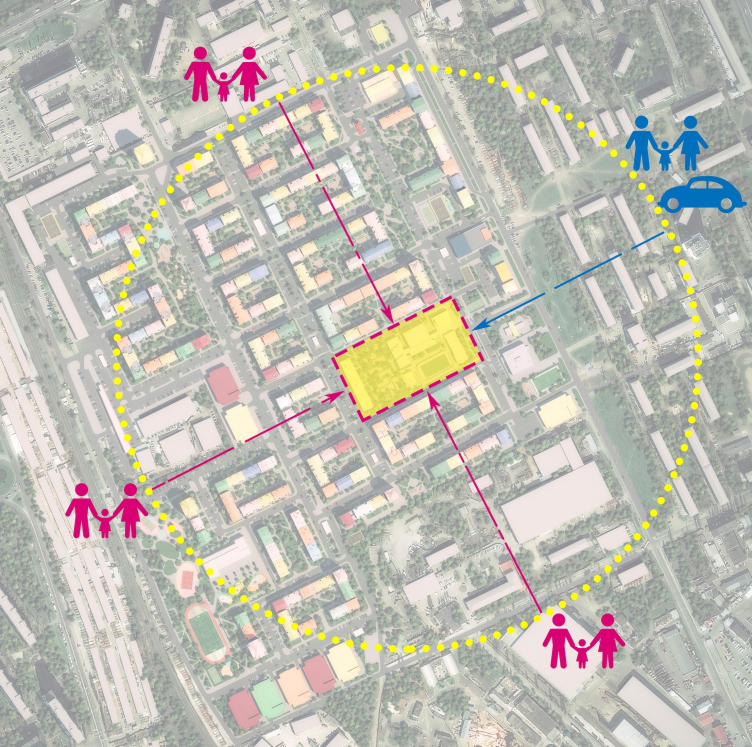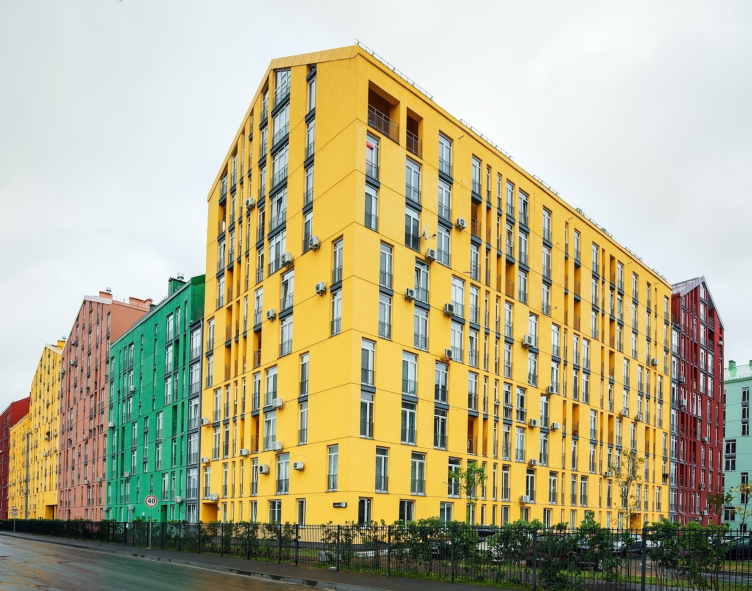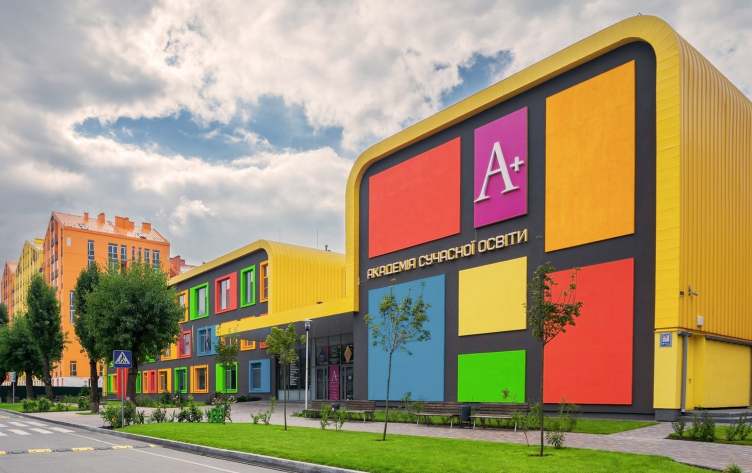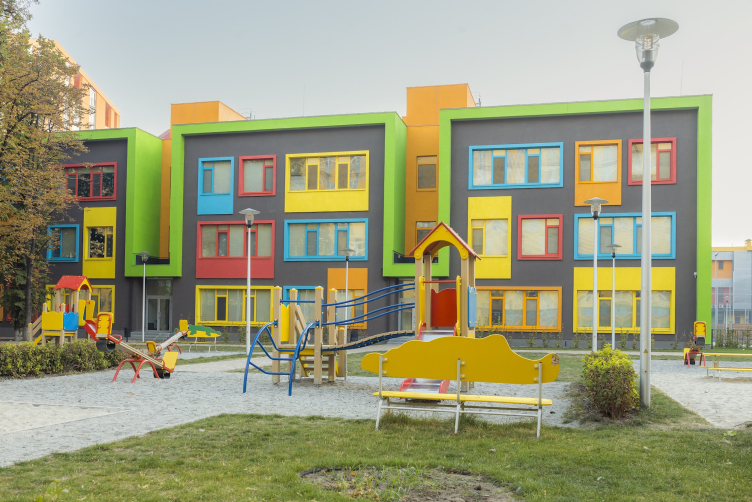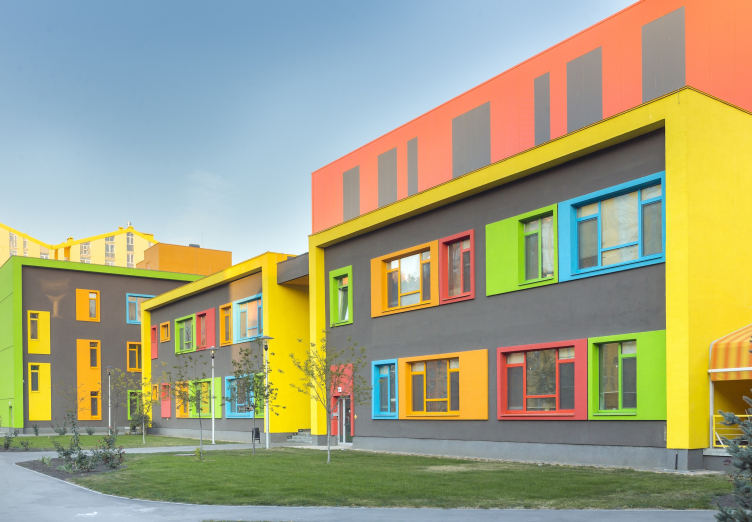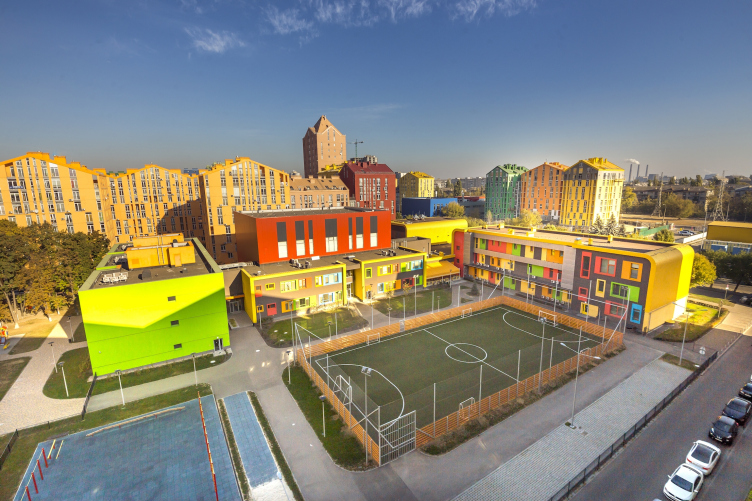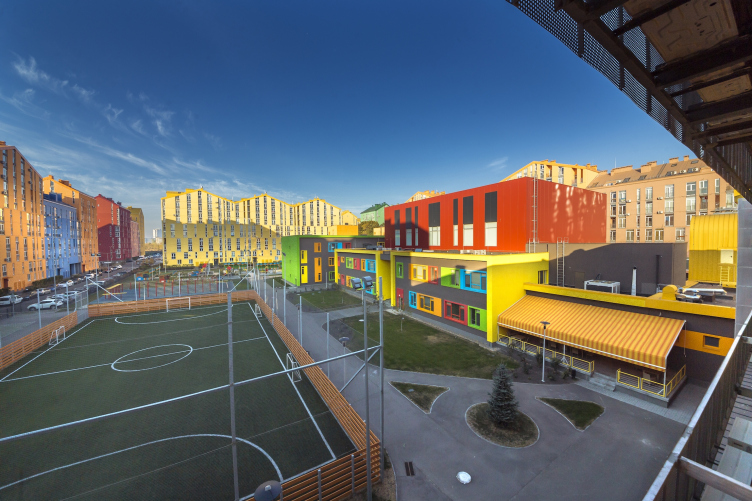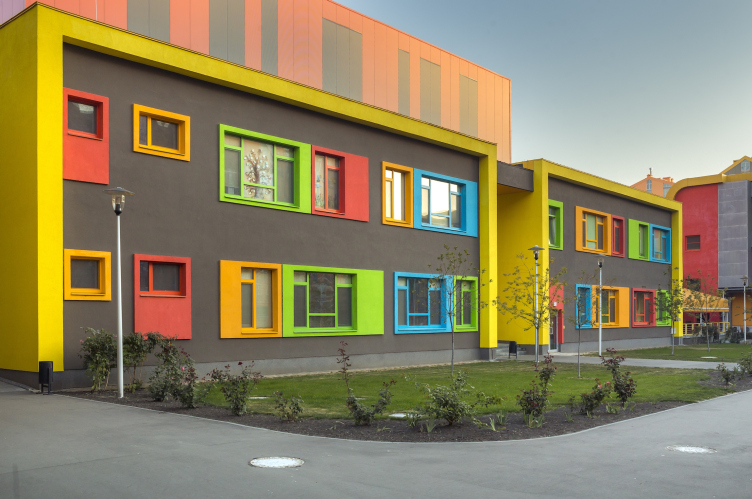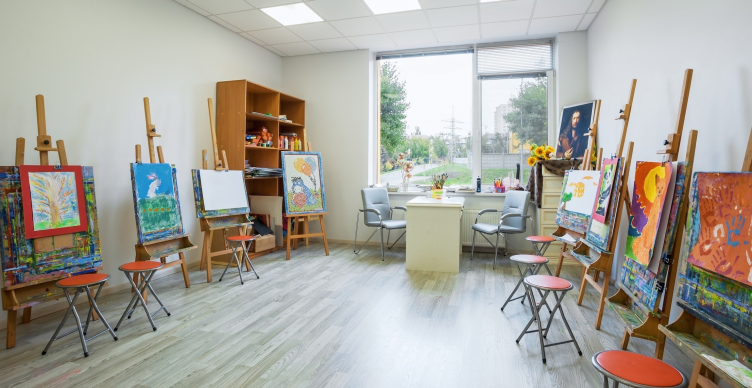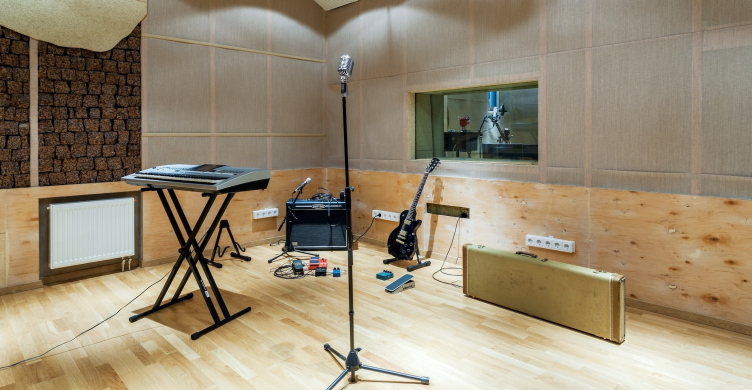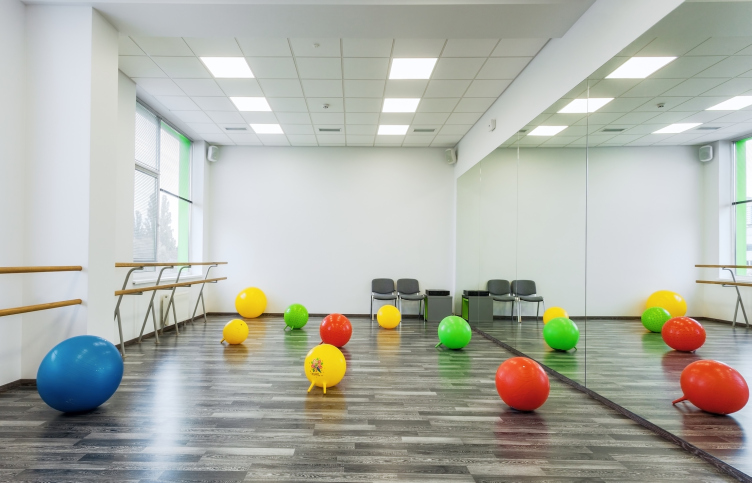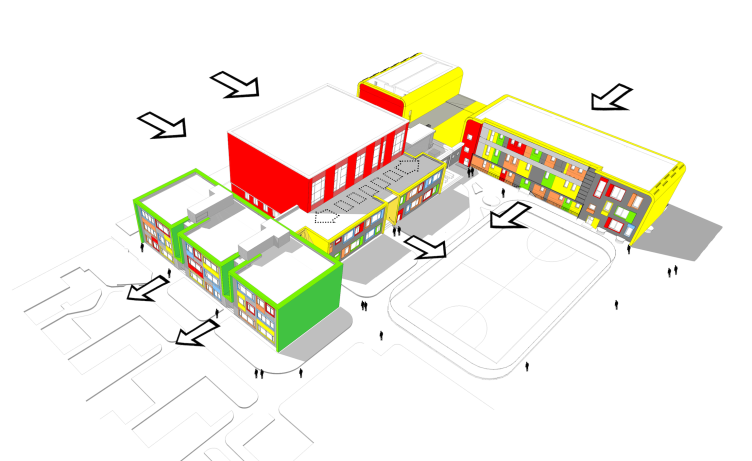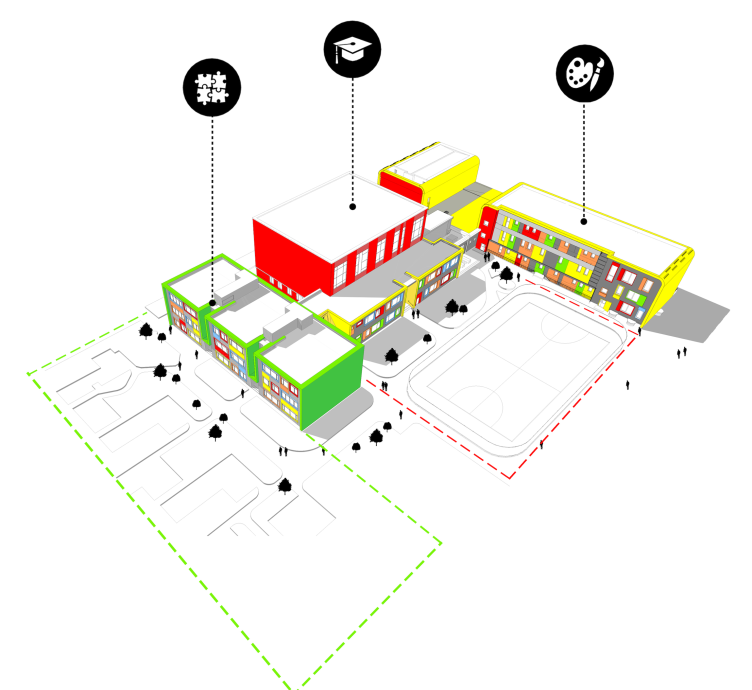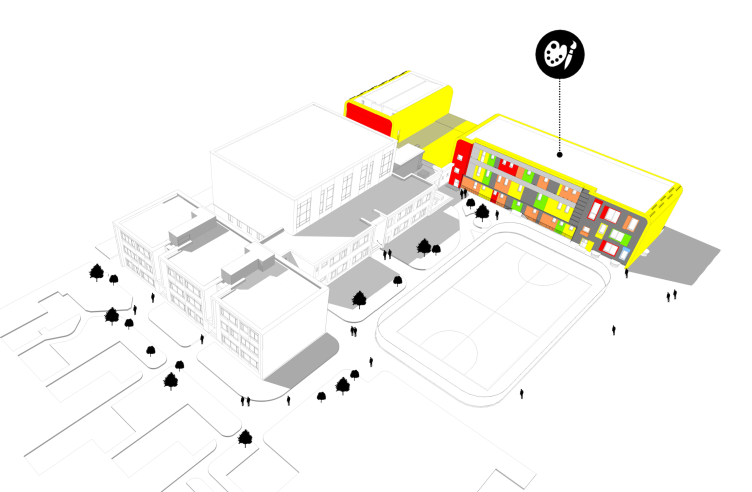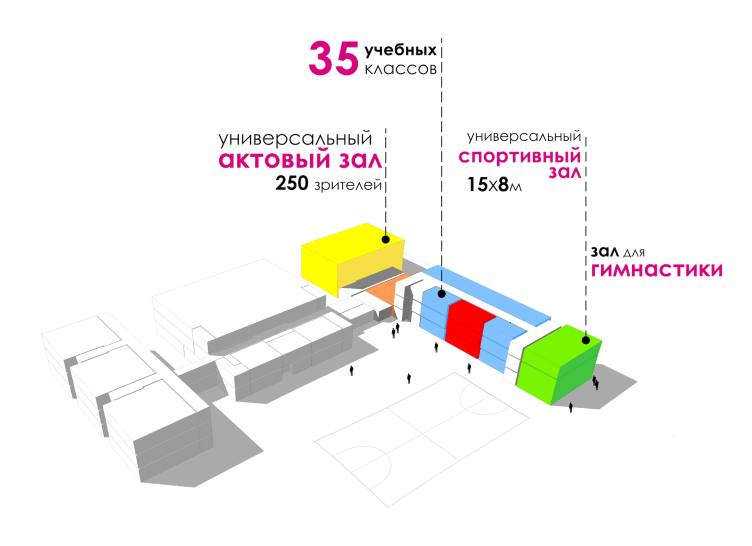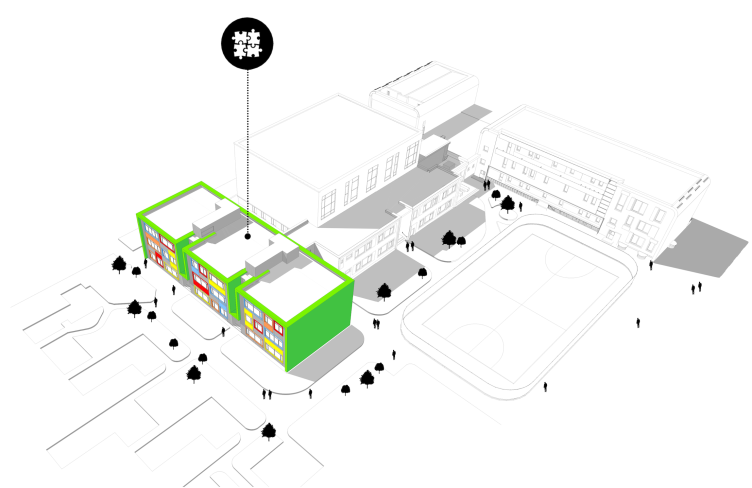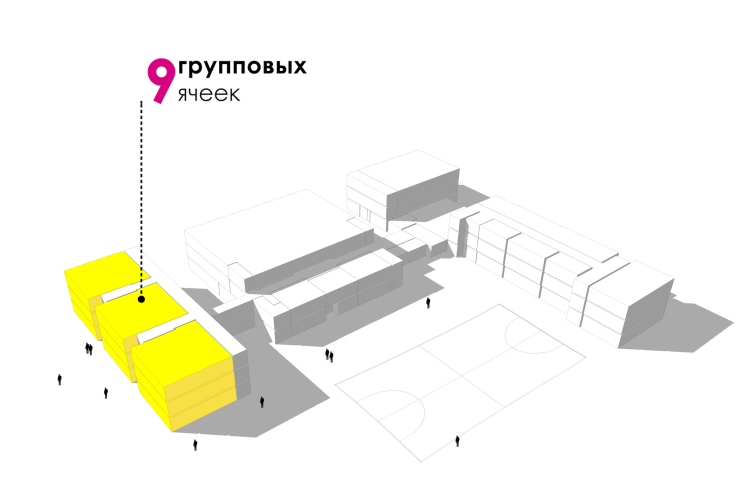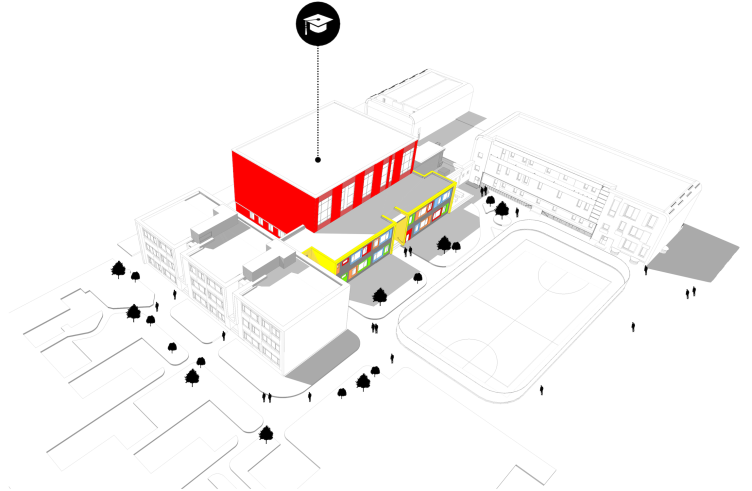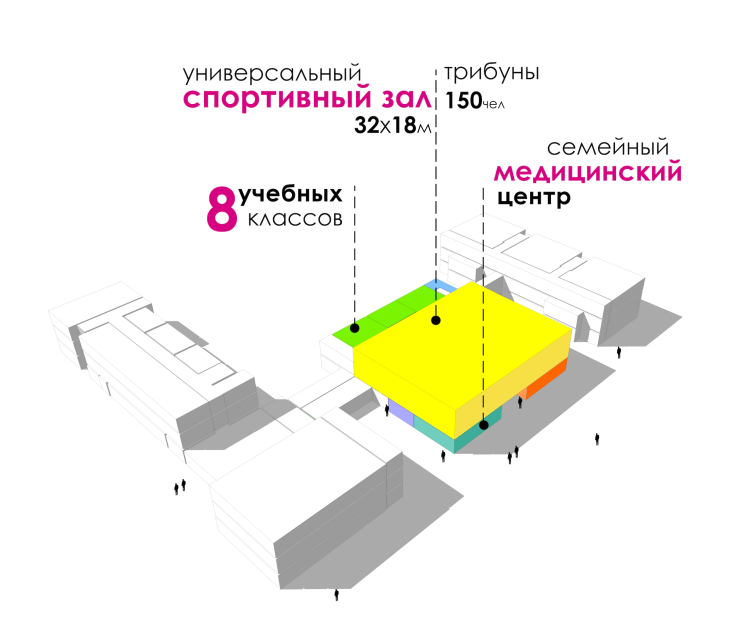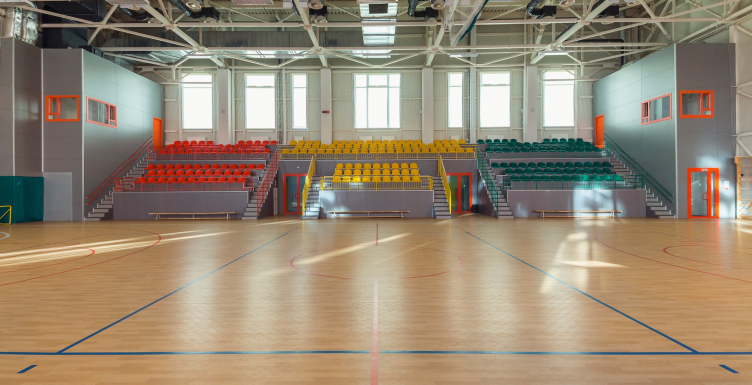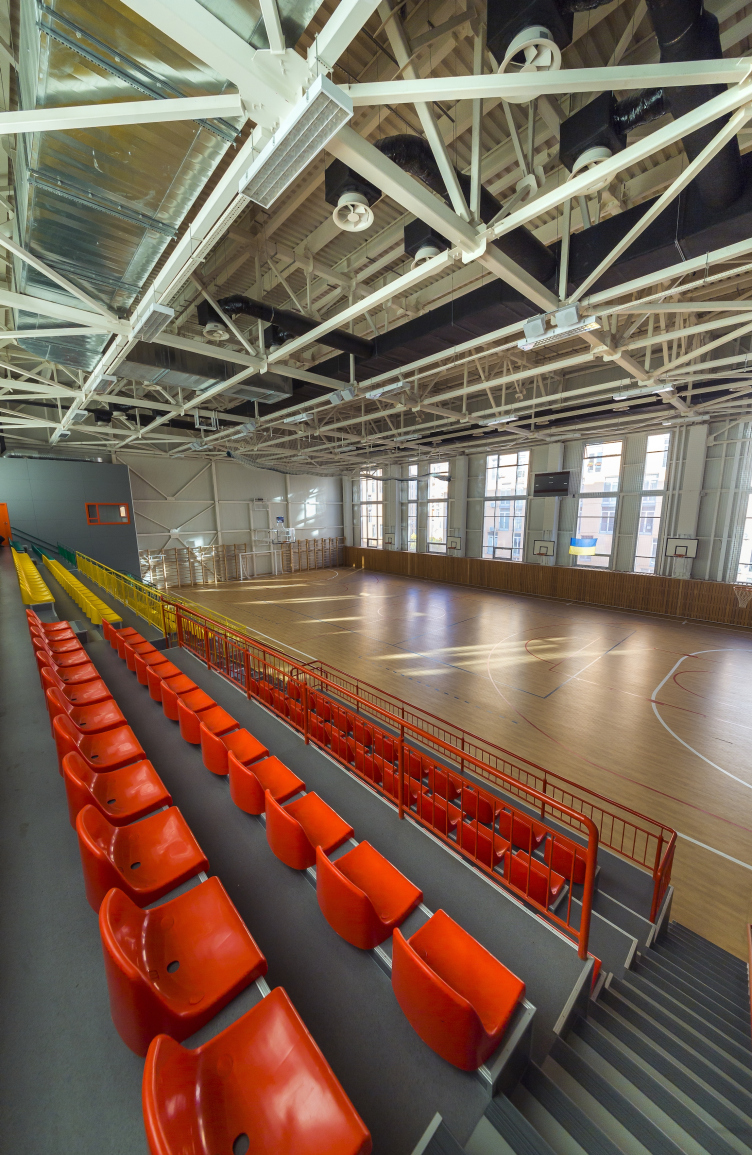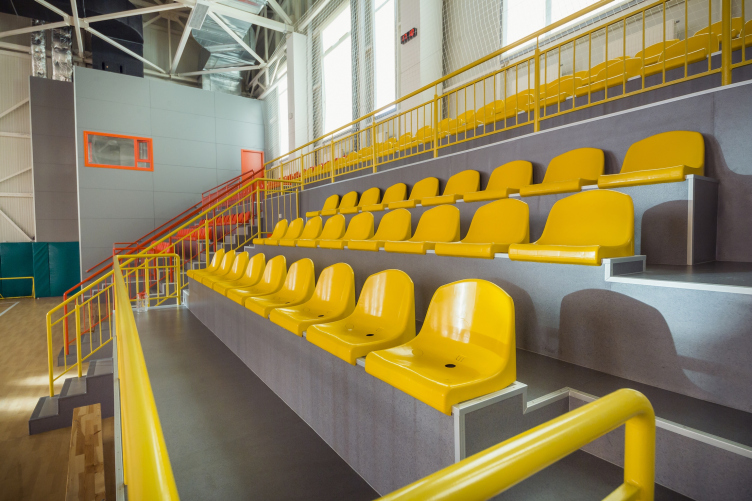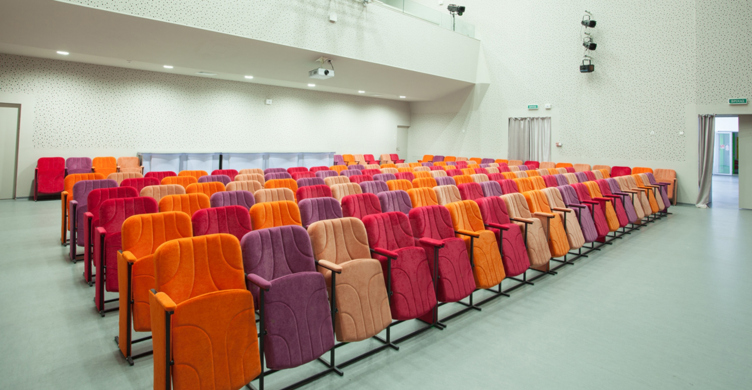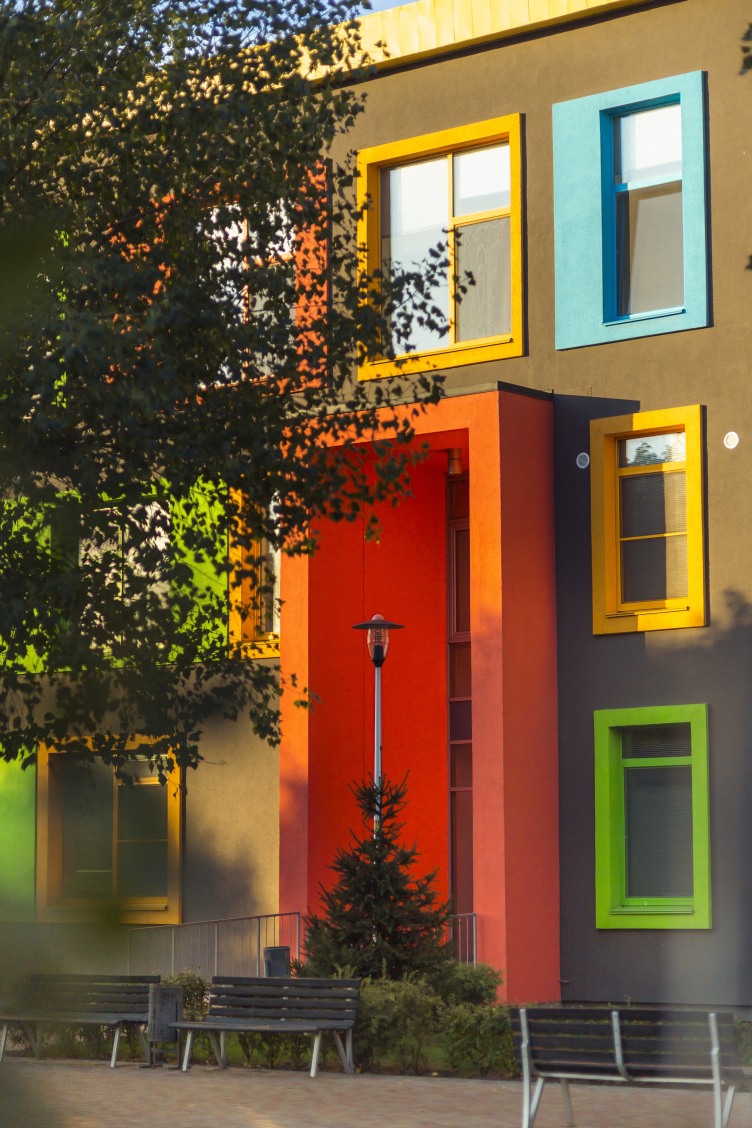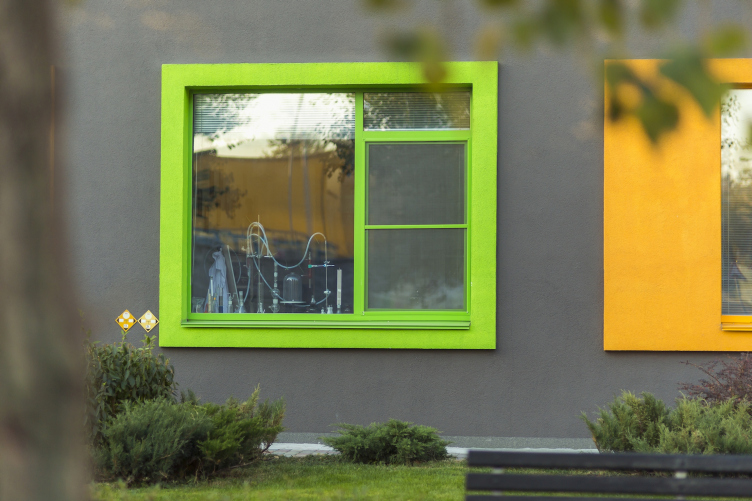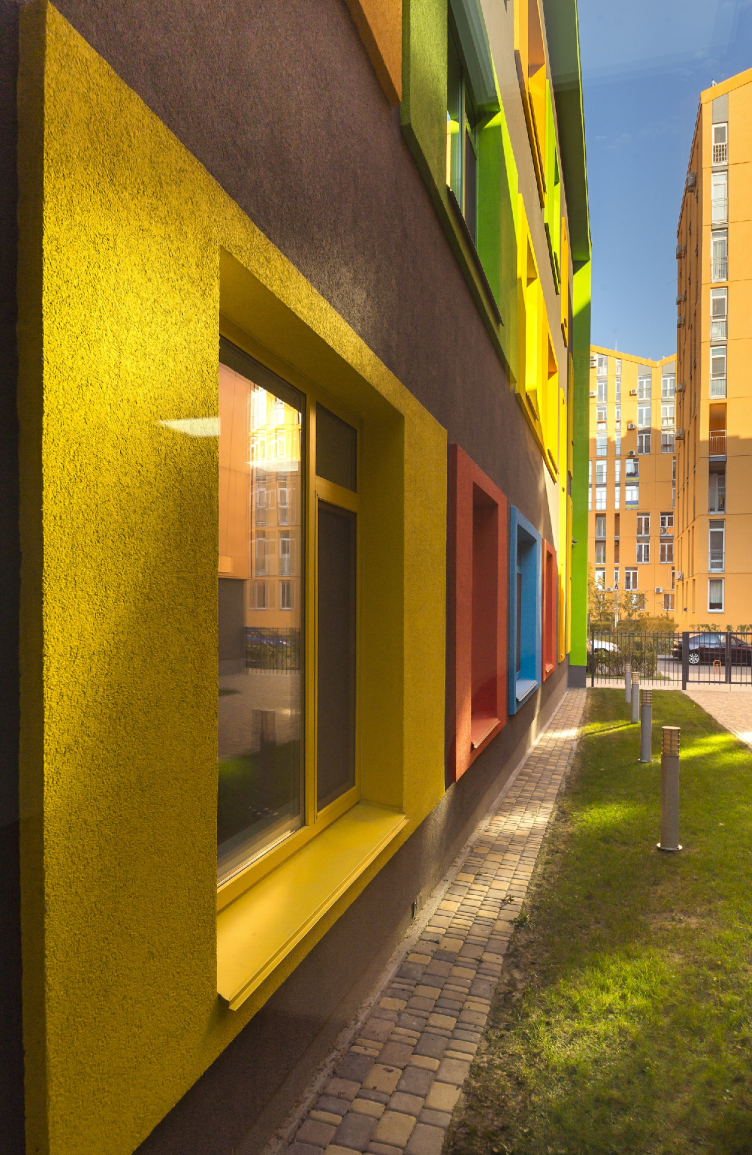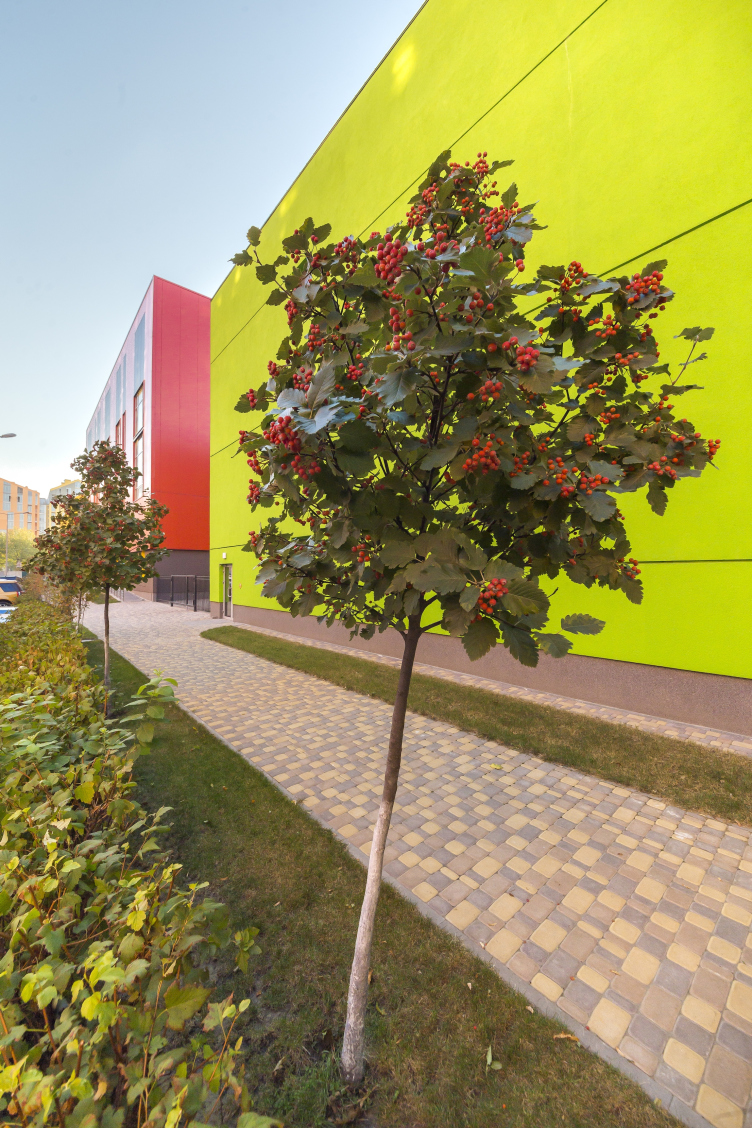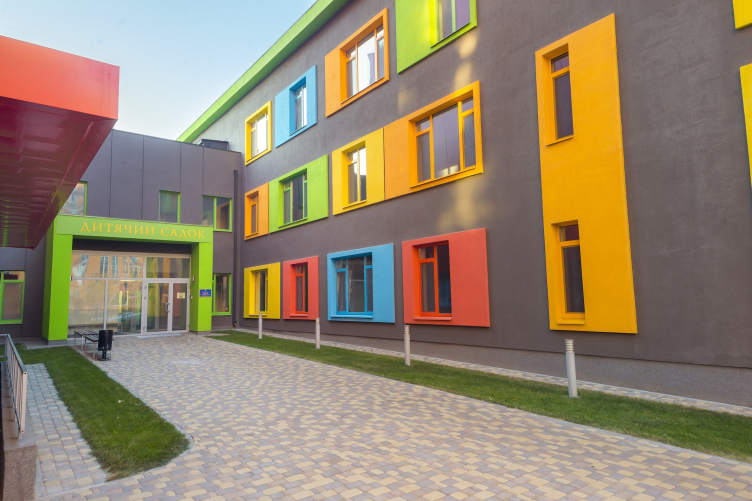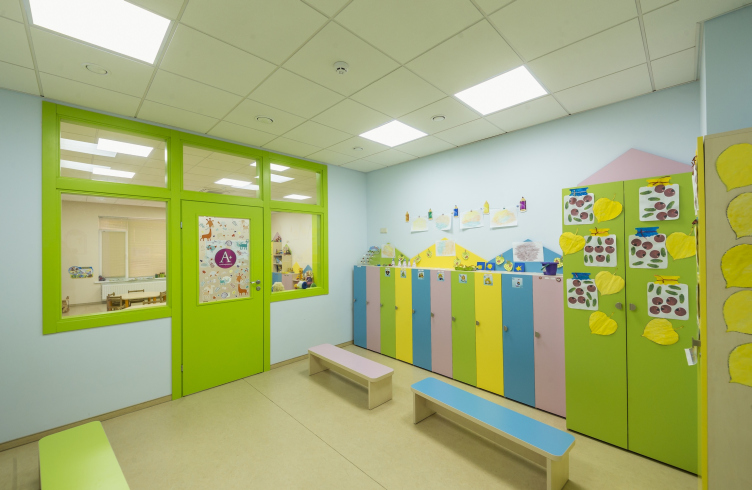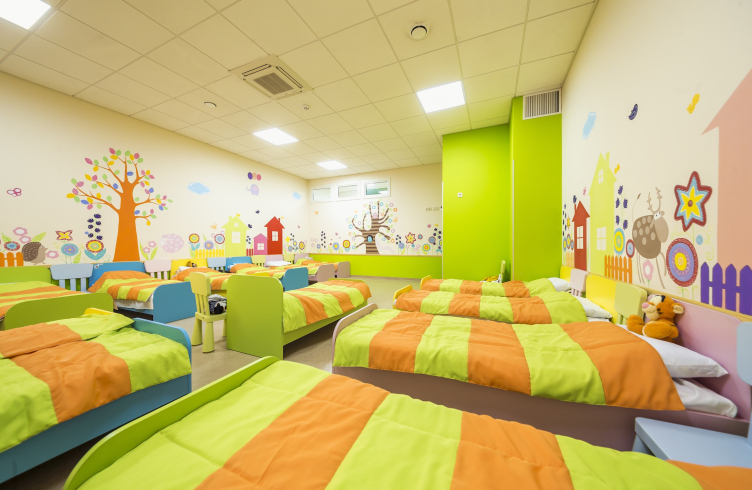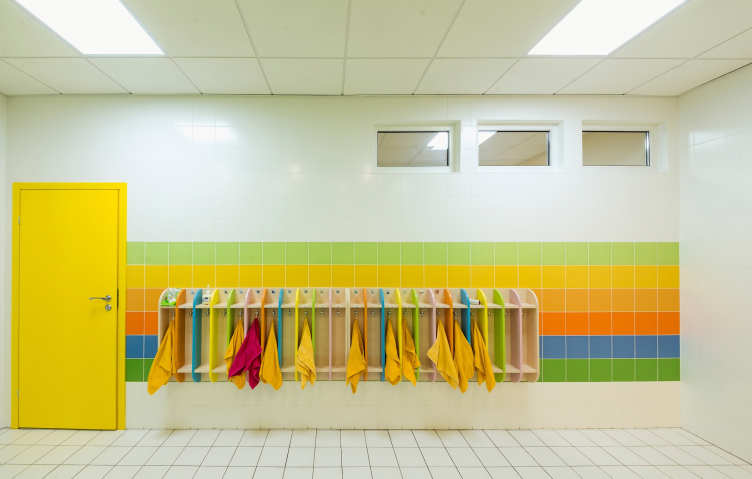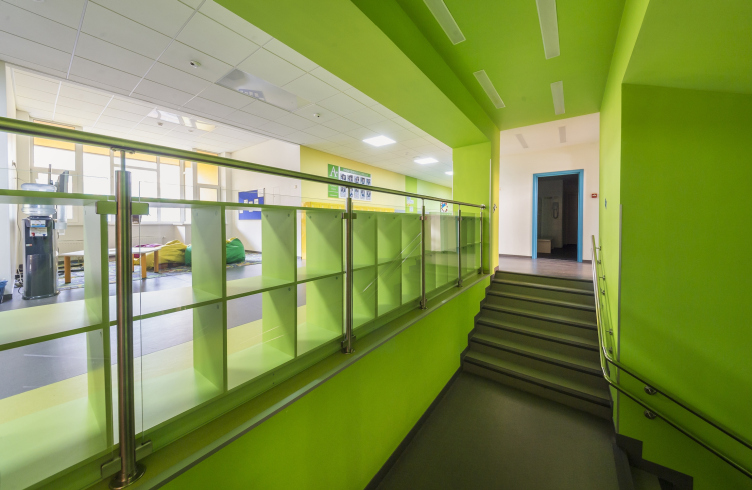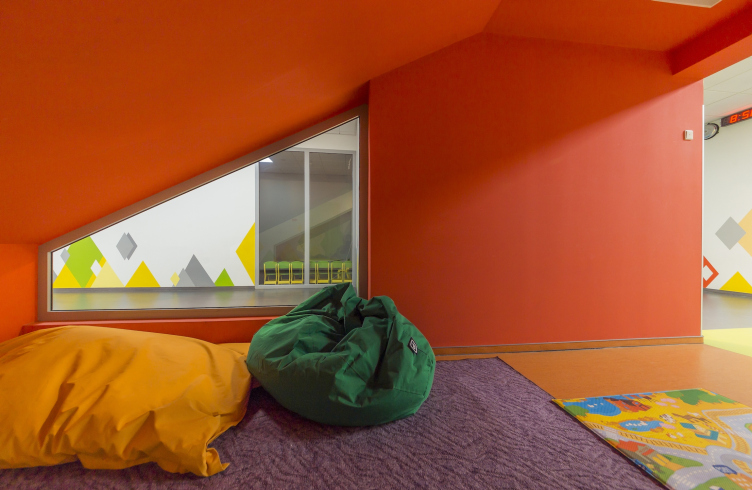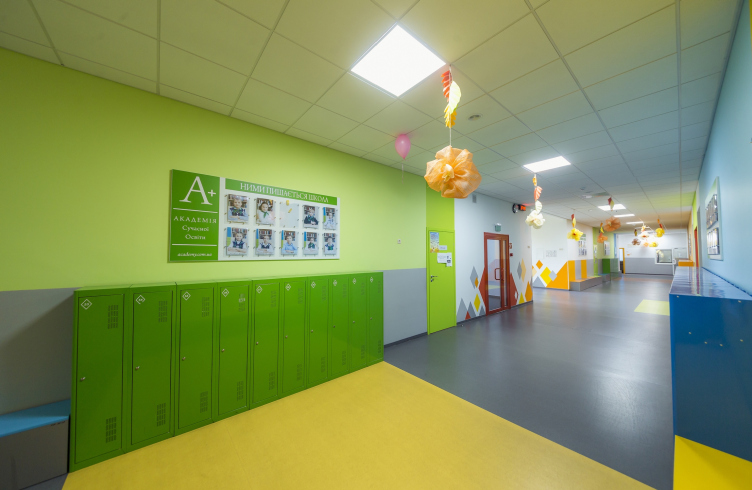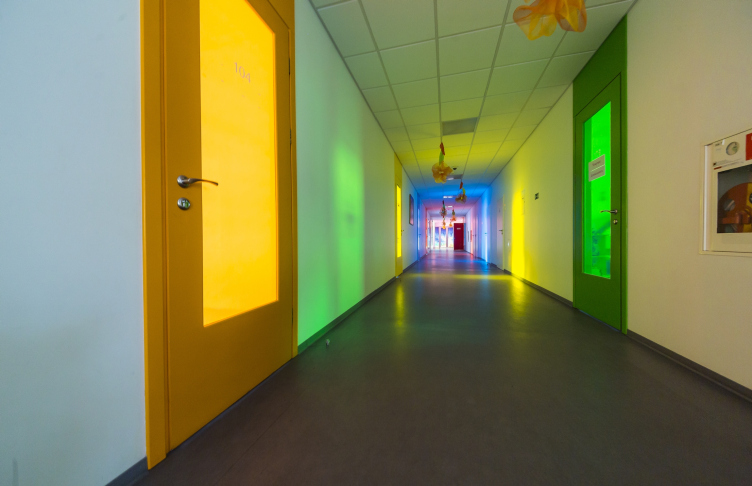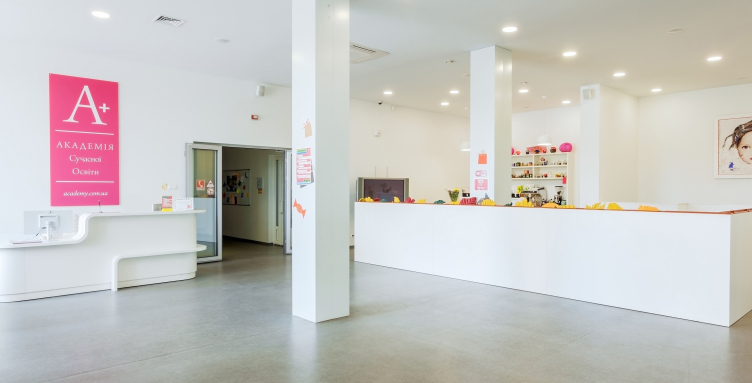“To me, this is a very personal project – says one of the cofounders of Archimatika, Alexander Popov – my parents, who were also architects, would always ask me for advice when they did a project that had to do with children one way or another. I was very happy because I felt that my parents could make my life better and more interesting. And now it was important for me to build such a school that I would be happy to have my son to go to, making his life more eventful. Which is how it ended up happening: every day I bring him here, and I am happy that I do”.
The school complex on the territory of "Comfort Town" residential area. The kindergarten unit. Construction, 2014 © Archimatika
The location plan of "Comfort Town" residential area. Construction, 2014 © Archimatika
The school complex on the territory of "Comfort Town" residential area. Birds-eye view. Construction, 2014 © Archimatika
The “high-profile” name of “Academy of Modern Education” stands up to the ambitions of the developer and the architects. While working on this advanced housing project in Kiev, they of course, studied the situation with the educational institutions in this area. The state-run schools and kindergartens, which were ready to accept children from the Comfort Town, were situated not really near, and it was decided to create for the little ones a dedicated infrastructure inside the city block, allotting a land plot in its center, equally accessible to the residents of Comfort Town, and all the residents of the nearby neighborhoods. Originally, the company “KAN Development” was planning to hand the school over to the city, but the municipality had to refrain from accepting the transfer of ownership, referring to the tight budget and the stipulated, for years to come, schedule of putting new projects into operation. Then, in spite of the difficult economic situation, and in spite of the absence of a well-established tradition of payable junior education, the company decided to take a chance and launch a commercial project. Essentially, all of these “givens” defined the structure and the organization of the new private school.
The school complex on the territory of "Comfort Town" residential area. Accessibility plan. Construction, 2014 © Archimatika
"Comfort Town" residential area. Master plan © Archimatika
The residential area Comfort Town on the Regeneratorskaya Street consists of multicolored houses under double-pitched roofs, from 6 to 16 stories high. The educational complex is lower in, only 2-3 stories high. It gives the architects an opportunity to make a peculiar “pause”, adding some air into otherwise dense construction, at the same time taking into account its parceling – it consists of volumes that are proportional to the surrounding houses. There are also a few independent volumes of different sizes. Every building in this block is completely individual and each block of the educational center got an individual design solution. “Public buildings must become centers of new residential areas – Aleksey Popov claims – while in the case of residential construction we were constrained by the choice of materials (we had to take into account the possibility of serial production of building materials, and the budget was initially constricted), the academic building lent itself to more expensive materials and more sophisticated design solutions that offset the modesty of the façade design of the residential buildings”.
"Comfort Town" residential area. Construction © Archimatika
The Academy of Modern Education on the territory of "Comfort Town" residential area. The kindergarten unit. Construction, 2014 © Archimatika
The school complex on the territory of "Comfort Town" residential area. The kindergarten unit. Construction, 2014 © Archimatika
The school complex on the territory of "Comfort Town" residential area. The junior high school. Construction, 2014 © Archimatika
The school complex on the territory of "Comfort Town" residential area. The birds-eye view. Construction, 2014 © Archimatika
The school complex on the territory of "Comfort Town" residential area. Construction, 2014 © Archimatika
"Comfort Town" residential complex © Archimatika
The kindergarten for 160 children, the junior high school for 140 students, and the art school visually constitute independent volumes, yet at the same time functionally they are a single organism. The idea was that the parents could bring their children here in the morning and take them back in the evening after work. At the same time, teachers assigned to each class or group will take their students after the lessons are over to individual classes that they select: foreign languages, chess, singing, painting, Lego, dancing, football, music, robotic science, gymnastics, and lots of other clubs. The dream of any modern parent is to be able to work undisturbed, without being interrupted in the middle of a business meeting, at the same time without curbing his or her child’s interests and without limiting the child’s possibilities.
The school complex on the territory of "Comfort Town" residential area. The junior high school. Construction, 2014 © Archimatika
The art studio on the territory of "Comfort Town" residential area. The school of fine arts. Construction, 2014 © Archimatika
The recording studio in the school of fine arts on the territory of "Comfort Town" residential area. Construction, 2014 © Archimatika
The gym in the school of fine arts on the territory of "Comfort Town" residential area. Construction, 2014 © Archimatika
The Academy of Modern Education on the territory of "Comfort Town" residential area. The kindergarten unit. Construction, 2014 © Archimatika
The inside infrastructure of the Academy of Modern Education on the territory of "Comfort Town" residential area. The kindergarten unit. Construction, 2014 © Archimatika
The school block in the educational complex on the territory of "Comfort Town" Construction, 2014 © Archimatika
The Academy of Modern Education on the territory of "Comfort Town" residential area. The kindergarten unit. Construction, 2014 © Archimatika
The kindergarten block in the educational complex on the territory of "Comfort Town" Construction, 2014 © Archimatika
The inside infrastructure of the Academy of Modern Education on the territory of "Comfort Town" residential area. The kindergarten unit. Construction, 2014 © Archimatika
The junior high block in the educational complex on the territory of "Comfort Town" Construction, 2014 © Archimatika
The functional content of the educational complex on the territory of "Comfort Town" Construction, 2014 © Archimatika
This merger also allowed the architects to pay much more attention to various auxiliary functional zones, thus raising the quality of infrastructure. For example, the mixed-use gym and the spacious auditorium, necessary for the operation of all divisions, got decent modern equipment, which would have been impossible had they been equipped as two separate units. A kindergarten alone or a school alone could not afford it. For this same reason, the complex got a full-fledged medical center which also serves the “outside” patients, at the same time providing qualified medical assistance to the students. Both streams are, of course, spaced apart. The kitchen also gets quite a load during the day, and therefore it is well equipped. Part of the bar counter of the café even sticks out to the lobby giving the parents an opportunity to visit together and snatch a quick cup coffee. And, finally, on the evenings and on the weekends the grownups can also come here to play volleyball or to dance. As a result, the load and the efficiency of the center’s operation is practically at its maximum.
The mixed-use gym of the educational complex on the territory of "Comfort Town" residential area. The kindergarten unit. Construction, 2014 © Archimatika
The mixed-use gym of the educational complex on the territory of "Comfort Town" residential area. The kindergarten unit. Construction, 2014 © Archimatika
The mixed-use gym of the educational complex on the territory of "Comfort Town" residential area. The kindergarten unit. Construction, 2014 © Archimatika
The mixed-use auditorium with a professional stage. Construction, 2014 © Archimatika
Alexander Popov is positive that investing in education is the right and noble thing to do: “Of course, this project can hardly generate tremendous revenue but to bring a decent return on investment and generally be successful – why not? The Soviet system of “Pioneer Palaces” (this is how centers for children’s extracurricular activities were called back then) is practically nonexistent now, and we need to be developing new formats answering today’s demand for development and socialization of children. You can say that I am too self-assured but the architect’s role in this matter is really important. The architectural environment ultimately defines the behavior of teachers and children alike. Of course, a lot depends on the specific teacher, specific principle or even specific chef, but if a school is more like military barracks, then everyone will have a hard time trying to overcome the gloomy and oppressive environment. So the main question that we kept asking ourselves when working on this project was: what can architects do to light a fire in the hearts of our children, to evoke in them the thirst for learning, mutual respect, and empathy?”
The school of fine arts on the territory of "Comfort Town" residential area. The kindergarten unit. Construction, 2014 © Archimatika
The school of fine arts on the territory of "Comfort Town" residential area. The kindergarten unit. Construction, 2014 © Archimatika
The kindergarten on the territory of "Comfort Town" residential area. The kindergarten unit. Construction, 2014 © Archimatika
The kindergarten and the junior high school on the territory of "Comfort Town" residential area. The kindergarten unit. Construction, 2014 © Archimatika
The kindergarten and the junior high school on the territory of "Comfort Town" residential area. The kindergarten unit. Construction, 2014 © Archimatika
The kindergarten on the territory of "Comfort Town" residential area. The kindergarten unit. Construction, 2014 © Archimatika
The kindergarten on the territory of "Comfort Town" residential area. The kindergarten unit. Construction, 2014 © Archimatika
The kindergarten on the territory of "Comfort Town" residential area. The kindergarten unit. Construction, 2014 © Archimatika
The kindergarten on the territory of "Comfort Town" residential area. The kindergarten unit. Construction, 2014 © Archimatika
The kindergarten on the territory of "Comfort Town" residential area. The kindergarten unit. Construction, 2014 © Archimatika
The junior high school on the territory of "Comfort Town" residential area. The kindergarten unit. Construction, 2014 © Archimatika
The junior high school on the territory of "Comfort Town" residential area. The kindergarten unit. Construction, 2014 © Archimatika
The school of fine arts on the territory of "Comfort Town" residential area. The kindergarten unit. Construction, 2014 © Archimatika
The lobby of the "Academy of Modern Education" on the territory of "Comfort Town" residential area. The kindergarten unit. Construction, 2014 © Archimatika



